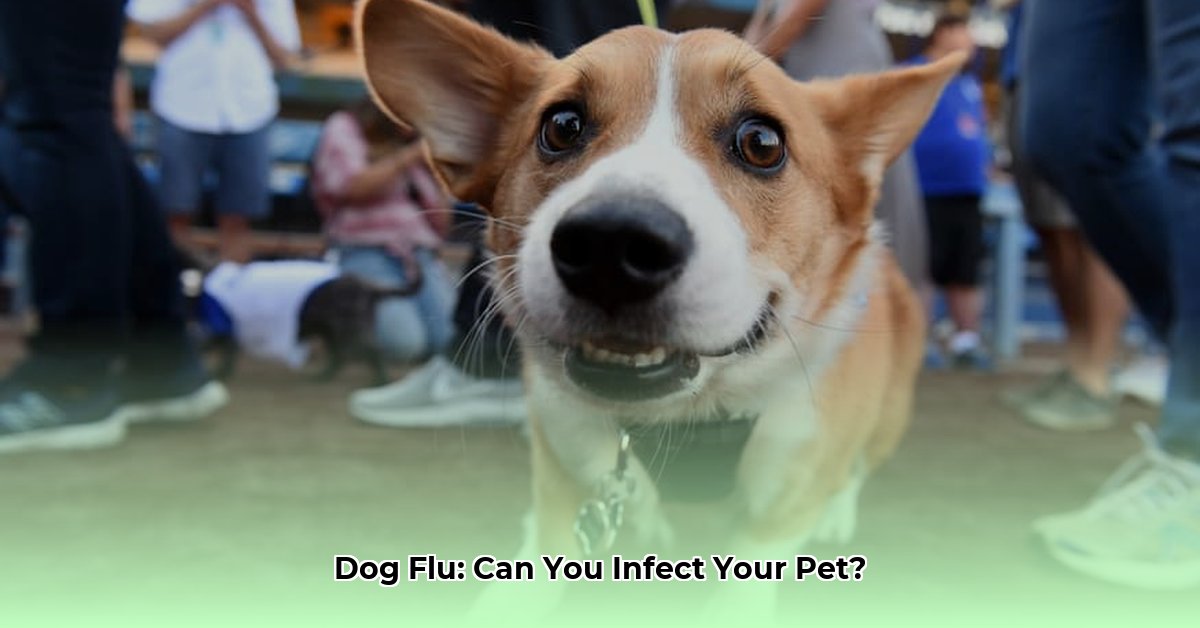Is your sniffling making your furry friend sick? It’s a common concern among pet owners. The good news is that while dogs can catch the flu from humans, it’s relatively rare. Let’s explore how to protect your canine companion.
Human Flu & Your Dog: What You Need to Know
It’s important to understand that human and canine influenza viruses, while related, are distinct. Dogs are much more susceptible to canine influenza, which they catch from other dogs. However, certain human flu strains, like H3N2 and H1N1, are known to occasionally infect dogs. Current research suggests this cross-species transmission isn’t common, but understanding the possibility is key to protecting your pet.
Spotting the Signs: Is Your Dog Ill?
If you suspect your dog might have the flu (whether from a human or another dog), look for these symptoms:
- Persistent Coughing: A dry, hacking cough that lingers can be a sign.
- Frequent Sneezing: Multiple sneezes in a row might indicate irritation.
- Nasal Discharge: A runny nose, clear or slightly colored, is common.
- Elevated Temperature: Use a rectal thermometer to check for a fever (consult your vet for guidance). A warm, dry nose isn’t always a reliable indicator.
- Lethargy/Fatigue: If your dog is unusually tired and uninterested in their usual activities, it’s a cause for concern.
- Appetite Loss: A sudden disinterest in food, especially favorite treats, may signal illness.
If your dog exhibits any of these symptoms, consult your veterinarian. While most dogs recover from the flu within a couple of weeks with supportive care, a vet can ensure your dog’s comfort and rule out other potential illnesses.
How Flu Spreads: Human to Dog
Flu transmission between humans and dogs typically requires close contact. Think nose-to-nose greetings, sharing water bowls, or even doggy kisses. The virus travels through respiratory droplets released when an infected person coughs or sneezes. Indirect contact with contaminated surfaces (like doorknobs or shared toys) can also play a role.
Protecting Your Pup: Prevention is Key
Here are some simple yet effective ways to minimize your dog’s risk:
1. Hand Hygiene is Crucial: Wash your hands thoroughly with soap and water after coughing, sneezing, or before interacting with your dog.
2. Disinfect Regularly: Clean and disinfect frequently touched surfaces in your home, including your dog’s bowls, toys, and bedding.
3. Limit Contact When Sick: If you’re unwell, minimize close contact with your dog. Ask a family member or friend to help care for your pet until you recover.
4. Consider Vaccination: The canine influenza vaccine primarily protects against dog-to-dog transmission. However, some experts believe it might offer some cross-protection against certain human flu strains. Discuss this option with your veterinarian, especially if your dog frequently interacts with other canines.
FAQs: Your Questions, Answered
- Can my dog give me the flu? It’s extremely rare for dogs to transmit influenza to humans.
- What should I do if I think my dog has the flu? Contact your veterinarian promptly for diagnosis and guidance.
- Is there a treatment for dog flu? There’s no specific cure, but supportive care (rest, fluids) can help manage symptoms and prevent complications. Your veterinarian may prescribe medications to alleviate coughing or reduce fever. Never give your dog human flu medication without consulting your vet.
- Are some dogs more at risk? Puppies, senior dogs, and those with weakened immune systems are generally more susceptible to infections, including the flu.
When to Contact a Vet
If your dog shows any flu-like symptoms, contact your veterinarian. Early intervention can make a significant difference in their recovery. Your vet can provide an accurate diagnosis and recommend appropriate care.
Further Information & Resources
Conclusion: Keeping Your Canine Companion Healthy
While it’s possible for your dog to catch the flu from you, it’s not a common occurrence. By practicing good hygiene and taking preventative measures, you can significantly reduce the risk and keep your furry friend happy and healthy. Remember, current research on canine influenza is ongoing, and recommendations may evolve. Stay informed and consult your veterinarian for the most up-to-date advice.
- The Best Bento Box Price For Your Perfect Packed Lunch - December 15, 2025
- Bento Box Shopping Tips for Smart and Stylish Lunch Prep - December 14, 2025
- Bento Box Trays Streamline Restaurant Meal Presentation and Transport - December 13, 2025










